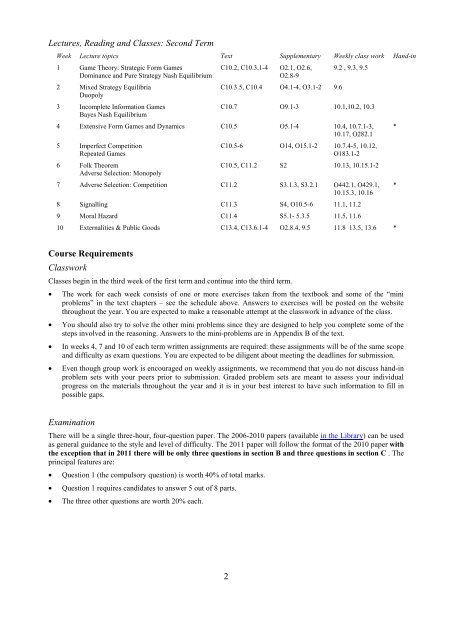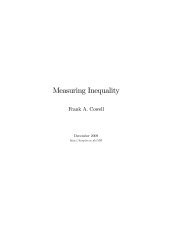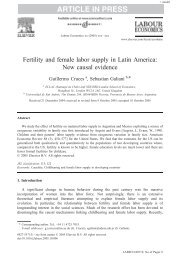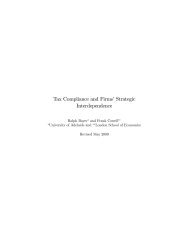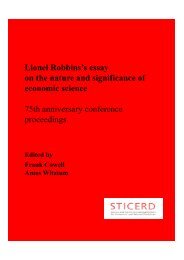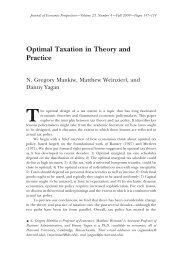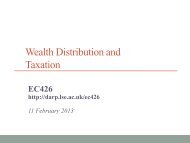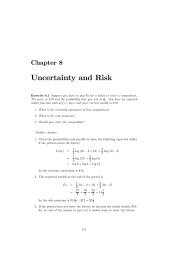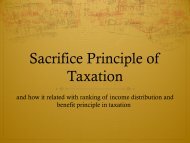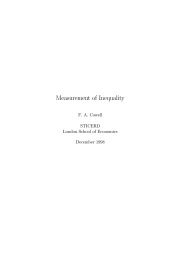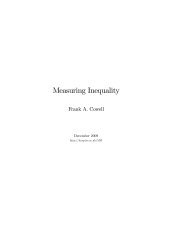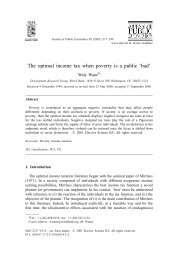EC202: Microeconomic Principles 2 2010/11 - DARP
EC202: Microeconomic Principles 2 2010/11 - DARP
EC202: Microeconomic Principles 2 2010/11 - DARP
You also want an ePaper? Increase the reach of your titles
YUMPU automatically turns print PDFs into web optimized ePapers that Google loves.
Lectures, Reading and Classes: Second Term<br />
Week Lecture topics Text Supplementary Weekly class work Hand-in<br />
1 Game Theory: Strategic Form Games<br />
Dominance and Pure Strategy Nash Equilibrium<br />
2 Mixed Strategy Equilibria<br />
Duopoly<br />
3 Incomplete Information Games<br />
Bayes Nash Equilibrium<br />
C10.2, C10.3.1-4<br />
O2.1, O2.6,<br />
O2.8-9<br />
C10.3.5, C10.4 O4.1-4, O3.1-2 9.6<br />
9.2 , 9.3, 9.5<br />
C10.7 O9.1-3 10.1,10.2, 10.3<br />
4 Extensive Form Games and Dynamics C10.5 O5.1-4 10.4, 10.7.1-3,<br />
10.17, O282.1<br />
5 Imperfect Competition<br />
Repeated Games<br />
6 Folk Theorem<br />
Adverse Selection: Monopoly<br />
C10.5-6 O14, O15.1-2 10.7.4-5, 10.12,<br />
O183.1-2<br />
C10.5, C<strong>11</strong>.2 S2 10.13, 10.15.1-2<br />
7 Adverse Selection: Competition C<strong>11</strong>.2 S3.1.3, S3.2.1 O442.1, O429.1,<br />
10.15.3, 10.16<br />
8 Signalling C<strong>11</strong>.3 S4, O10.5-6 <strong>11</strong>.1, <strong>11</strong>.2<br />
9 Moral Hazard C<strong>11</strong>.4 S5.1- 5.3.5 <strong>11</strong>.5, <strong>11</strong>.6<br />
10 Externalities & Public Goods C13.4, C13.6.1-4 O2.8.4, 9.5 <strong>11</strong>.8 13.5, 13.6 *<br />
*<br />
*<br />
Course Requirements<br />
Classwork<br />
Classes begin in the third week of the first term and continue into the third term.<br />
• The work for each week consists of one or more exercises taken from the textbook and some of the “mini<br />
problems” in the text chapters – see the schedule above. Answers to exercises will be posted on the website<br />
throughout the year. You are expected to make a reasonable attempt at the classwork in advance of the class.<br />
• You should also try to solve the other mini problems since they are designed to help you complete some of the<br />
steps involved in the reasoning. Answers to the mini-problems are in Appendix B of the text.<br />
• In weeks 4, 7 and 10 of each term written assignments are required: these assignments will be of the same scope<br />
and difficulty as exam questions. You are expected to be diligent about meeting the deadlines for submission.<br />
• Even though group work is encouraged on weekly assignments, we recommend that you do not discuss hand-in<br />
problem sets with your peers prior to submission. Graded problem sets are meant to assess your individual<br />
progress on the materials throughout the year and it is in your best interest to have such information to fill in<br />
possible gaps.<br />
Examination<br />
There will be a single three-hour, four-question paper. The 2006-<strong>2010</strong> papers (available in the Library) can be used<br />
as general guidance to the style and level of difficulty. The 20<strong>11</strong> paper will follow the format of the <strong>2010</strong> paper with<br />
the exception that in 20<strong>11</strong> there will be only three questions in section B and three questions in section C . The<br />
principal features are:<br />
• Question 1 (the compulsory question) is worth 40% of total marks.<br />
• Question 1 requires candidates to answer 5 out of 8 parts.<br />
• The three other questions are worth 20% each.<br />
2


